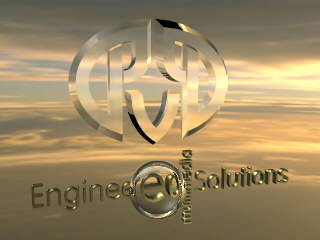
The term photorealistic rendering implies that the final result will be a "picture" or "movie" that closely resembles the real thing. To achieve a photorealistic rendering, materials need to be mapped to the different portions of the mesh. To achieve such an effect a number of different properties need to be defined for each part of the model: texture, opacity, reflection, refraction, ambient/diffuse/specular colors, and so forth. Next, "lights" and "cameras" need to be set up, and, if required, the model can be animated. All parts of a 3D model can be moved in all three dimensions, sometimes defying the laws of physics.
The image below is a still-frame from an animation for broadcast video. The objects in the logo are texture/reflection/refraction mapped. Note the refractive properties of the glass sphere as it passses in front of the gold lettering. The lights and the enviroment are reflected and refracted in the logo.

Look at a rendering of 3 spheres.
Rendering is the process that turns a mesh model into a computer animation. For every frame of the animation, the computer calculates how all of the geometry will look, taking all of the pre-defined properties into account. This is usually a very time-consuming process. Depending on the complexity of the model, the "materials" used, the resolution, and the color depth (- the number of colors used -), this can take from a few seconds to a half hour or more per frame, which would cause the rendering of a relatively complex one minute animation to take days or even weeks! That's where multiple processor rendering becomes a necessity ....
In some cases, the rendering may be done in "real time". This allows the user more interactive control over the environment. The software then renders the new scene based on the user's input. As objects are moved, they are instantly re-rendered. Some of the new interactive games employ this method. However, the processing power of the computer poses serious limitations on the quality of the resulting images. These limitations mean that the picture is normally at a lower resolution with fewer colors. The newer graphics accelerators now come with 3-D hardware to carry some of the processing load in the 3-D department.